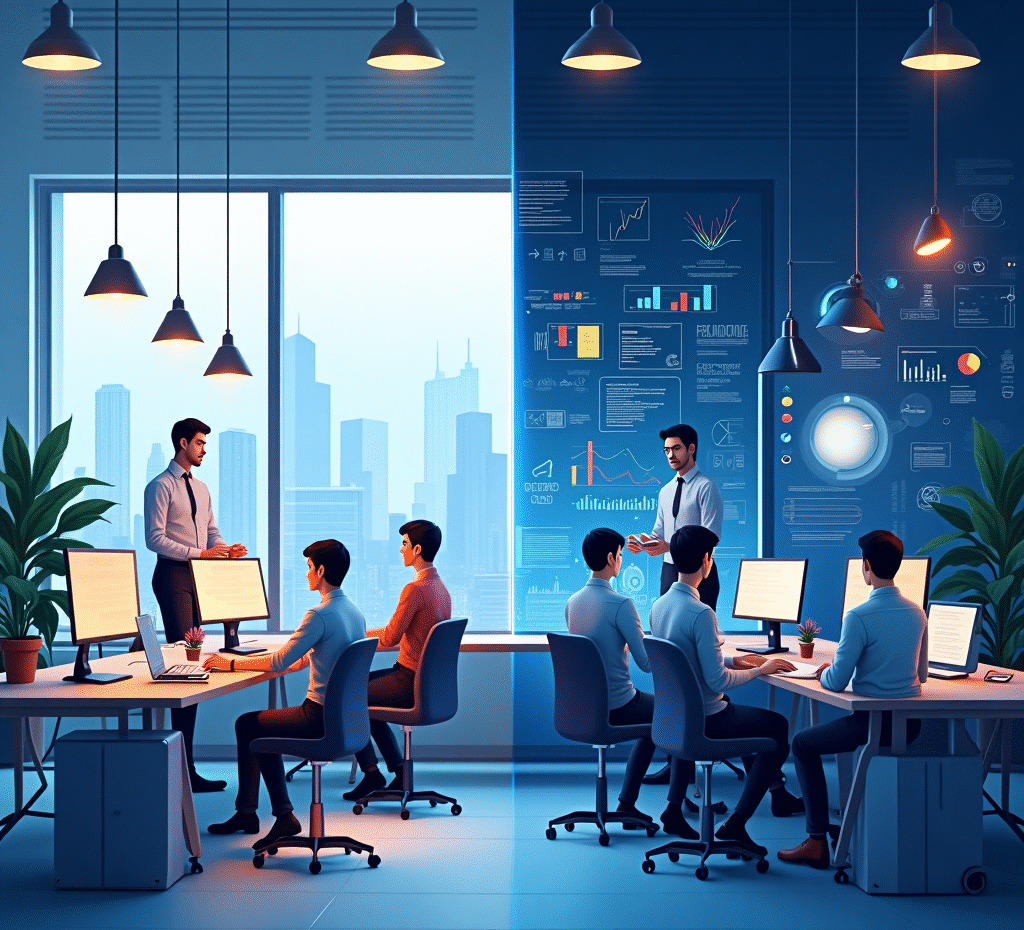- June 12, 2025
- by admin
AI and the Job Market: What’s Next for Workers?
Artificial Intelligence (AI) has moved from the realm of futuristic speculation into a force shaping the global economy and the workplace. It’s already automating tasks, reshaping industries, and redefining the skills employers value. As headlines warn of robots taking over jobs and algorithms replacing humans, professionals across industries are asking: What’s next for workers in the age of AI?
The truth is, AI’s impact on the job market is both disruptive and transformative. While some roles will be displaced, many new ones are emerging. The challenge lies not in resisting this shift but in preparing for it, adapting to it, and learning how to work alongside intelligent systems rather than fear them.
🚀 The Acceleration of Automation
It’s no secret that automation has been steadily replacing repetitive, rule-based tasks across sectors. But with AI, this capability has expanded dramatically:
- In manufacturing, robots not only assemble parts they inspect quality using computer vision.
- In customer service, chatbots resolve thousands of queries a day without human intervention.
- In finance, AI systems assess credit risk, detect fraud, and even manage investment portfolios.
- In healthcare, AI helps interpret X-rays, optimize workflows, and personalize treatment plans.
What used to be a threat only to blue-collar roles is now extending into white-collar jobs, including analysts, copywriters, HR professionals, and even junior developers.
But this doesn’t mean AI is coming for all jobs it’s reshaping the tasks within them.
🔁 Jobs Won, Jobs Lost: The Balance of AI Disruption
According to research by the World Economic Forum, AI and automation will displace around 85 million jobs globally by 2025. But at the same time, they are expected to create 97 million new roles better suited for the new division of labor between humans, machines, and algorithms.
That means AI will reconfigure work more than eliminate it.
Let’s look at what’s changing:
Likely DisplacedLikely EmergingData entry clerksAI trainers & auditorsTelemarketersPrompt engineersRoutine accountantsData ethicistsBasic graphic designersHuman-machine UX designersSimple customer serviceAI operations managers
The roles being phased out are those that rely heavily on predictable, repeatable actions. Meanwhile, roles that require creativity, strategic thinking, emotional intelligence, and oversight of AI systems are on the rise.
🧠 The Skill Shift: What Workers Need Now
As AI takes over more tasks, human workers must evolve their skillsets to stay relevant. That doesn’t mean everyone must learn to code but it does mean we need to embrace lifelong learning and adaptability.
🔹 In-demand skills for the AI era:
- Critical thinking and problem-solving – AI can surface insights, but humans still ask the right questions.
- Digital literacy – Understanding how AI tools work, even at a conceptual level.
- Collaboration and emotional intelligence – Human interaction remains irreplaceable.
- Data interpretation – Reading and contextualizing AI-generated outputs.
- Creativity and innovation – AI is a tool, but it can’t imagine or dream the way humans do.
In short, the future belongs not just to coders but to adaptable thinkers.
🛠️ Reimagining Work: Humans + AI, Not Humans vs. AI
The best companies aren’t replacing employees with AI they’re augmenting their workforce. In this model, AI handles time-consuming or data-heavy tasks, freeing up humans to focus on high-value activities.
For example:
- Recruiters use AI to screen resumes, but still rely on human judgment for interviews and cultural fit.
- Doctors use AI to diagnose conditions faster, but provide the empathy and decision-making that machines can’t.
- Designers and writers are using generative AI to brainstorm ideas, not to fully replace their creative process.
AI is not replacing jobs it’s changing how they’re done. Companies that understand this synergy will outperform those who treat AI as a cost-cutting tool alone.
🌍 Global Inequality and Access
While AI creates opportunity, it also risks widening the gap between those who can access new technologies and those who can’t. Workers in developing countries, low-income regions, or underserved communities may be disproportionately affected unless there are systems in place for upskilling, education, and support.
Governments and businesses must take shared responsibility:
- Invest in affordable training programs.
- Build public-private partnerships for reskilling.
- Make AI tools accessible to small businesses and freelancers, not just large enterprises.
AI should be a force multiplier not a divider.
📈 What Can Workers Do Today?
Here’s a practical roadmap for workers navigating the AI transformation:
1. Audit Your Role
Which parts of your job are repetitive or predictable? These are the most likely to be automated. Focus on growing the parts that require human insight.
2. Learn How AI Works
You don’t need to become a machine learning engineer, but understanding the basics (e.g., how chatbots or recommendation engines work) can make you smarter about using and managing AI tools.
3. Upskill Continuously
Take short courses, attend webinars, or participate in company training. Focus on hybrid skills like combining marketing with data science or HR with automation tools.
4. Stay Curious and Open
The ability to learn and unlearn is the ultimate skill in a rapidly evolving workplace.
✨ The Future Isn’t Human or Machine, It’s Both
AI isn’t the end of jobs it’s the end of certain kinds of jobs. If history has taught us anything, it’s that technological revolutions always bring labor transitions. The printing press, the steam engine, and the internet all changed what work looked like but they didn’t erase the need for people.
As we move forward, the question isn’t “Will AI take my job?” It’s “How can I evolve with AI to create a better one?”
The winners in the AI economy will be those who learn to collaborate with machines, not compete with them.

